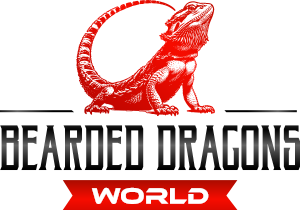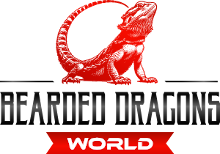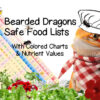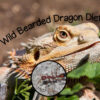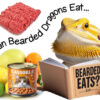Getting calcium for bearded dragons right is crucial for good health but can get a little confusing, especially when adding vitamin D3 into the equation.
Dr Amna Ahmad is a Doctor of Veterinary Science graduated from the University of Agriculture, Faisalabad, Pakistan.
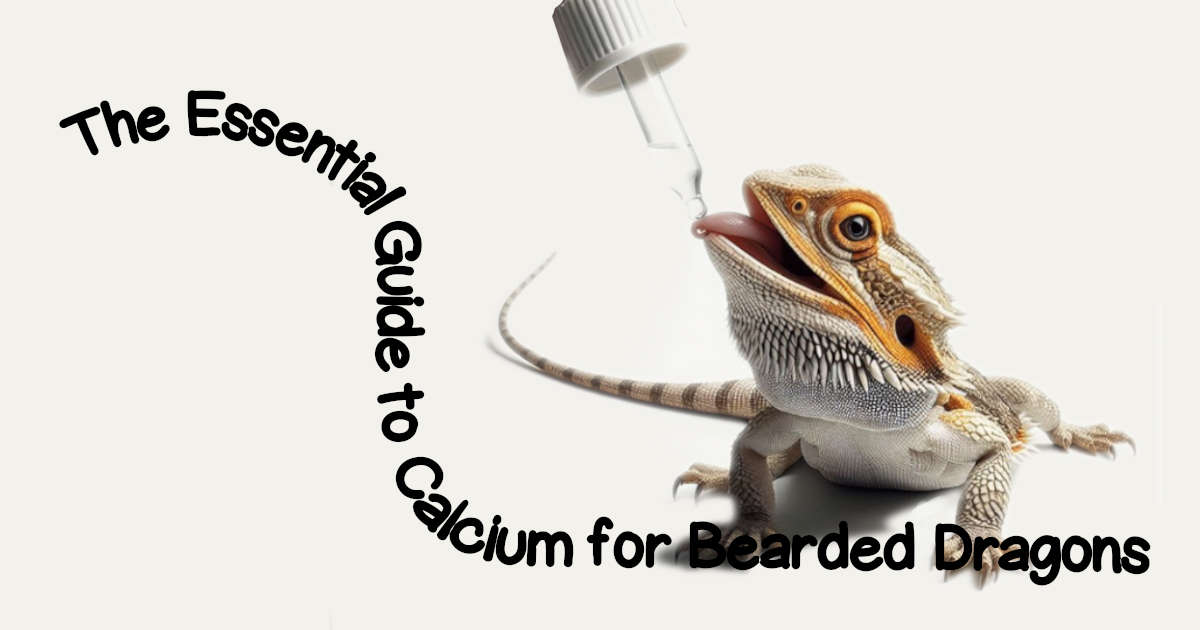
Jump To…
Key Takeaways for Calcium for Bearded Dragons:
- Balance the Ca:P Ratio: Aim for a diet that supports a healthy balance, with a focus on calcium-rich foods and proper hydration.
- Diversify the Diet: Incorporate a variety of vegetables, greens, and occasional fruits to ensure a broad spectrum of nutrients.
- Moderation and Caution: Be mindful of foods that may inhibit calcium absorption and use them sparingly.
- Best Calcium Source: Powdered calcium carbonate is a breat source of calcium for bearded dragons.
Is Calcium for Bearded Dragons Needed?
Calcium for bearded dragons is critical for their health. Calcium is like the superhero nutrient for bearded dragons. Calcium for bearded dragons is needed for:
- Strong bones
- Muscle function
- Blood clotting
- Heart health
- Nervous system
The effectiveness of calcium absorption in bearded dragons heavily relies on vitamin D3, serving as a crucial facilitator or ‘unlocking’ mechanism for calcium’s entry into their system. This highlights the importance of proper supplementation with calcium for bearded dragons to ensure their health and well-being.
A lack of basic knowledge regarding the supplementation of calcium and Vitamin D3 has led to numerous preventable ailments among these reptiles. This emphasizes the need for awareness and education on calcium for bearded dragons.
A significant study by Schmidt et al. in 2017, which examined 529 bearded dragons across three exotic animal clinics in Central Europe, revealed some concerning statistics. The findings indicated that more than half of the dragons tested had an imbalance in their calcium-phosphorus ratio, with a majority displaying signs of hypocalcemia. Moreover, nearly one-fifth of the examined dragons suffered from musculoskeletal issues, notably osteodystrophy and limb fractures, underscoring the critical need for proper nutritional management and the vital role of calcium for bearded dragons.
Optimizing Calcium for Bearded Dragons: Balancing UVB Light and Nutrition
Just like humans need sunlight to help their bodies produce vitamin D, reptiles need sunlight for their health too, particularly UVB light. Here’s how it works:
Reptiles have a substance in their skin called 7-dehydrocholesterol. When they bask in sunlight, specifically under UVB rays which are a type of ultraviolet light, this substance is transformed into vitamin D3.
This process is most effective at a specific wavelength of UVB light, and it’s also dependent on the reptile having an adequate body temperature. This is why you see reptiles basking in the sun; they’re not just warming up, they’re also making vitamin D3, which is crucial for calcium for bearded dragons.
However, there’s a balance needed. Too much UVB can lead to the production of substances that aren’t useful for the reptile’s body. But, nature is clever and has provided a way for these unused substances to be stored in the skin and potentially converted back to the useful form when needed, acting like a reserve.
The need for UVB varies among reptile species, largely depending on their natural habitats and behaviors. For instance, reptiles that are active during the day in the wild usually have skin that’s less sensitive to UVB compared to those that are active at night or at dusk, like some geckos. This means, as a pet owner, the type of reptile you have can determine the amount and type of UVB lighting they need in their enclosure to ensure adequate calcium.
It’s also important to note that there are safety mechanisms in place within the reptile’s body that prevent too much vitamin D3 from being produced from UVB exposure. That means there’s a low risk of vitamin D3 overdose from sunlight or UVB lamps alone.
For optimal health, it’s not just about the UVB exposure. Diet plays a crucial role too. For instance, ensuring your bearde dragons diet has enough calcium can help prevent metabolic bone disease, a common issue in captive reptiles.
It’s essential to mimic your reptile’s natural environment as closely as possible in their enclosure. This includes providing the right type of UVB light, maintaining proper temperature gradients, hydration and offering a diet that meets their nutritional needs.
Managing Calcium for Bearded Dragons
How Often to Feed Calcium to Bearded Dragons
Bearded dragons do not need calcium every day. As a generalisation, the recommendation of numerous veterinarians, researchers and herpetologists is as follows:
| Stage | Supplementation Frequency |
|---|---|
| Hatchlings | 4-5 times a week |
| Juvenile | 4-5 times a week |
| Adult | 2-3 times a week |
| Reproductively active females | 3-4 times a week |
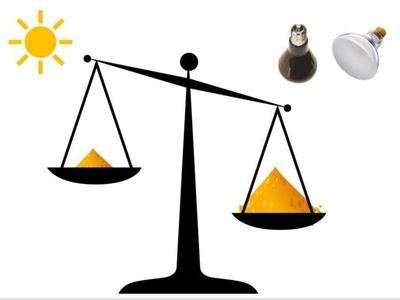
How Much Calcium to Give Bearded Dragons
How much calcium do bearded dragons need? Calcium for bearded dragons can be a bit of guesswork as there are so many variables involved. It is best to follow the supplement manufacturers guidelines.
A dose of calcium is likely to be as little as an 1/8 of a teaspoon or a pinch such as with Vetark who have brought their measures down to ‘pinches’ to make it easy. However keep in mind some of the variables that influence how much calcium supplementation is required:
- Biological stage of the animal.
- The amount of calcium that sticks to the food.
- How well insects were gut loaded.
- The quality of calcium supplement being used.
However, if you are feeding your bearded dragon 50% or more of the total diet with commercially prepared diets, supplementation should not be required (Stahl and Donoghue 2010) or at least reduced to prevent over supplementation. Check the ingredients of the food before supplementing and speak with your vet for guidance.
Calcium and Phorphorus Balance
Getting the calcium for bearded dragons just right isn’t only about how much they get, but also about the balance with phosphorus in their diet. Think of it like a see-saw: you want to keep it balanced for your dragon to grow strong and healthy.
Why the Balance Matters:
- For Growing Dragons: They need more calcium, so aim for a calcium to phosphorus ratio of 2:1. This helps them build strong bones.
- Adult Dragons: Their needs are a bit less, with a good balance being around 1.5:1.
- Egg-Laying Females: They need a lot more calcium, so their ratio can go all the way up to 10:1 during these times to support egg development.
Here’s a simple breakdown of what that looks like in their diet:
| Life Stage | Calcium (% of dry matter) | Phosphorus (% of dry matter) | Calcium:Phosphorus Ratio |
|---|---|---|---|
| Growing Bearded Dragons | 1-1.5% | 0.5-0.9% | 2:1 |
| Adult Bearded Dragons | 1-1.5% | 0.5-0.9% | 1.5:1 |
| Gravid (Egg-Laying) | 1-1.5% | 0.5-0.9% | Up to 10:1 |
Getting the right raio of calcium for bearded dragons aids in their overall health and bones.
What is the Best Calcium for Bearded Dragons?
When it comes to calcium for bearded dragons there are a few choices. However, calcium carbonate powder is the top choice. Calcium can also be in a liquid form.
The best biologically available calcium is calcium carbonate. Calcium carbonate is 40% absorbed in the GI tract which other forms of calcium cannot come close to (Boyer, 2021). Never buy calcium for bearded dragons with phosphorus in it.
Best Powdered Calcium for Bearded Dragons
Simple and cheap powdered calcium carbonate is one of the best forms of calcium for bearded dragons. Calcium carbonate powders can be purchased from health food shops.
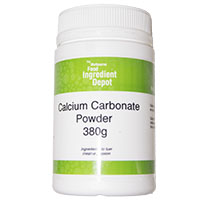
Powdered calcium is the most common form of supplement for bearded dragons and is widely recommended by veterinarians and reptile enthusiasts. It’s typically dusted over insects or vegetables, ensuring your bearded dragon receives calcium with their regular meals.
Pros:
- Easy to control dosage by adjusting the amount of powder used.
- Long shelf life and does not require refrigeration.
- Ensures that calcium is directly ingested with food.
Cons:
- Some bearded dragons may refuse food dusted with too much powder.
- It can be messy and may not coat live food evenly.
Suitable calcium for bearded dragons kept indoors with inadequate UVB is powdered form with cholecalciferol, also known as vitamin D3.
For bearded dragons kept indoors with adequate access to a well set out environment with UVB, outdoors, have outdoor time without glass or other barriers to block UVB, it is likely that lower levels of vitamin D3 will be needed.
Buying calcium powder both with and without vitamin D3 will provide options for alternate dusting. Avoid any calcium powder that has phosphorus in it. Calcium supplement meant for humans can also be used.
Liquid Calcium and How to Use It
Liquid calcium supplements can be easy to administer but they are a poor choice for quality. Sprays have been found to be lacking sufficient calcium with some as low as 1700ppm which is equal to 0.17%. (Boyer, 2021)
You can give it to them directly in their mouth, mix it into their water supply or lightly coat their food with it. However, mixing in water has its challenges. It is best to give liquid calcium to bearded dragons by a small eye dropper.
Pros:
- Easy to mix with water or food, ensuring even distribution.
- Can be more easily ingested by bearded dragons, especially those with feeding difficulties.
Cons:
- Sprays may be lacking sufficient calcium.
- It may be challenging to measure precise dosages.
- Liquid supplements can spoil or degrade faster than powdered forms if not stored properly. To maintain their potency, liquid calcium supplements should be stored according to the manufacturer’s instructions, typically in a cool, dark place and used within the recommended timeframe after opening. It’s also important to ensure the cap is tightly sealed after each use to minimize exposure to air and potential contaminants.
Calcium as Meal Bone
A pinch of bone meal powder may be a good source of calcium for bearded dragons however, make sure it’s safe for reptiles. The bone meal may be better used in feeding insects rather than direct to the reptile.
Pros:
- Bone meal is an excellent source of calcium.
- It can easily be sprinkled over insects and vegetables, making it a convenient way to add calcium to your bearded dragon’s diet.
- Being derived from bones, it is a natural source of calcium, potentially offering other micronutrients.
Cons:
- This is not a common form and no studies have been found to validate its benefits or dangers to bearded dragons.
- Not all bone meal products are created equally or with reptiles in mind. Make sure the product is free from harmful additives and is safe for reptile consumption.
- Bone meal also contains phosphorus. An improper calcium-to-phosphorus ratio can hinder calcium absorption, so the balance must be monitored.
- Some bearded dragons might find bone meal-dusted food less appealing, which could affect their willingness to eat.
Calcium from Cuttlefish
Cuttlebone, derived from cuttlefish, may serve as an excellent natural source of calcium. Composed primarily of aragonite (crystallized calcium carbonate), cuttlebone offers a highly absorbable form of calcium.
In order for the calcium from cuttlebone to be effectively utilized, it needs to be in powdered form. According to Dr. Boyer (2021), observations have shown that when cuttlebone is fed to tortoises in chunks, it passes through their digestive system, appearing whole in their feces. To ensure a more precise intake of calcium and enhance the likelihood of absorption, it is advisable to use calcium carbonate powder instead.
An alternative method of utilizing cuttlebone involves placing it in the reptiles water dish. As it gradually dissolves, it releases calcium. However, a drawback of this approach is the inability to accurately gauge the amount of calcium being consumed by the bearded dragon. This can lead to overdosing or underdosing and subsequently health issues.
Optimizing Calcium for Bearded Dragons Through Their Diet
Providing adequate calcium for bearded dragons involves more than just dietary supplementation; it requires a holistic approach that includes proper UVB lighting, temperature regulation to mimic natural basking conditions, and possibly even probiotic supplementation to support gut health and mineralization. These factors together ensure the optimal health and well-being of bearded dragons, highlighting the intricate interplay between diet, environment, and physiology in reptile care.
Here are some practices to adjust to improve calcium for bearded dragons uptake:
Improve Calcium Absorption
- Gut Loading and Dusting: Increase the calcium content of feeder insects by gut loading them with calcium-rich foods and dusting them with calcium powder. Soldier fly larvae are especially beneficial due to their naturally higher calcium to phosphorus (Ca:P) ratio (Divers, 2018).
- Hydration: Keep your bearded dragon well-hydrated. Adequate water intake supports nutrient absorption, digestion, and waste elimination.
- UVB Light & Heat: Provide proper UVB light and heat, preferably including outdoor exposure to sun and heat within the care regime.
Oxalates and Phytates Can Block Calcium Absorption in Bearded Dragons
Foods high in oxalates and phytates have the potential to inhibit the uptake of calcium.
Oxalic and phytic acids bind to calcium making it unavailable. However, these foods can be added in small portions occasionally to a healthy bearded dragons diet (Stahl and Donoghue, 2010; Boyer, 2021). If they are fed, feed in small portions alternating with other foods.
Broccoli, Kale and Bok Choy are examples of foods rich in calcium but also have high oxalate and goitrogen that is often claimed to negatively affect their nutritional importance.
Calcium-Rich Foods to Include in a Diet
Adding a range of foods high in calcium to your bearded dragon’s diet is key for keeping the calcium to phosphorus (Ca:P) ratio balanced. Below are some recommended options, but it’s important to remember that focusing on one nutrient might impact the balance of others.
- Alfalfa
- Cilantro
- Collard Greens
- Dandelion Greens
- Endive/Chicory
- Escarole
- Mulberry Leaves
- Mustard Greens
- Parsley
- Romaine Lettuce
- Turnip Greens
- Watercress
Foods to use Cautiously
While certain foods are rich in phosphorus or contain compounds that may hinder calcium absorption, this doesn’t mean they should be entirely excluded from the diet. These foods might offer other nutritional benefits. See the dietary guide for further information.
| High Phosphorus Foods | High Oxalate Foods |
|---|---|
| Bananas | Broccoli |
| Pinkie mice | Kale |
| Muscle meat | Bok Choy |
| Squash and pumpkin seeds | Spinach |
| Pea sprouts | Peas |
| Celery | Beans |
| Peas | Beetroot |
What is the Best Way to Give a Bearded Dragon Calcium?
- Give Calcium by Lightly Dusting Food
Sprinkle some calcium carbonate powder on insects. Just a light coating will do.
Dusting only needs to occur as per the calcium supplementation schedule, not necessarily every day. Excessive calcium can be unpalatable. Foods dusted with too much calcium will probably be refused.
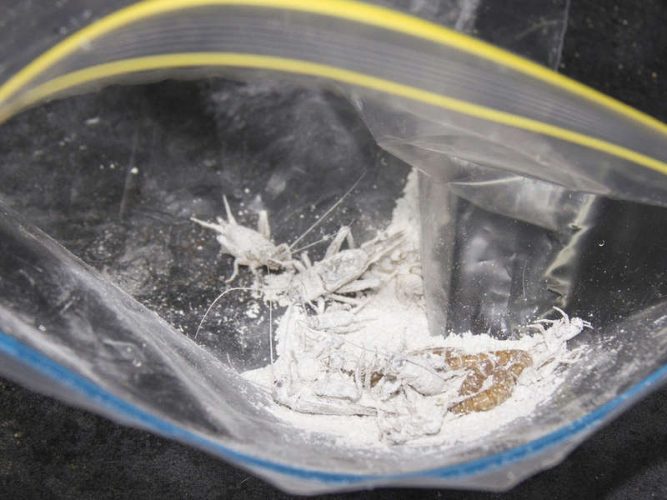
- Provide Some Vegetation High in Calcium
Some vegetation is higher than others in calcium and can be added to the diet. - Give Calcium by Gut-loading Insects
Feed the insects a nutritious meal before giving them to your dragon including calcium carbonate. This process enhances the nutritional value of the insects. However, the nutrients in gut-loading is not healthy for the insects so the diet can only be fed within 12-24 hours before feeding them to your reptile.
Some invertebrates, such as crickets, cannot be kept alive on calcium gut loading diet for over 3 days as it causes impaction in the cricket and subsequently it dies (Thompson, 2016). - Can you put calcium powder in bearded dragons water?
Yes you can put calcium for bearded dragons in their water. While it’s technically possible to put calcium powder in bearded dragons’ water, it’s not the most effective way to ensure they receive calcium.
Calcium powder doesn’t dissolve well in water, which can lead to inconsistent dosages and potentially inadequate calcium intake. Instead, direct supplementation by dusting their food with calcium powder is recommended to ensure that your bearded dragon receives the proper amount of calcium.
Vitamin D3: The Sunshine Vitamin
Bearded dragons need Vitamin D3 to metabolise and absorb calcium. The body cannot use calcium unless it has vitamin D3. However, Vitamin D3 can be overdosed, which can harm your bearded dragon’s health.
The best source of vitamin D3? Good old sunshine, and it is the safest too. UVB rays from the sun or a UVB bulb help your dragon produce Vitamin D3 naturally. If your bearded dragon is basking in natural sunlight (no glass or plastic in between), they’re getting a good dose of D3. But if they are not taken outdoors, you’ll need to make sure their UVB lighting is up to par.
Where UVB lighting is provided and even better where direct sunlight is available to the bearded dragon, D3 is not required. The requirements of D3 for reptiles are poorly understood and carries risks since safe levels are not known (Boyer, 2021). D3 is normally fed to nocturnal reptiles that do not have exposure to UVB lights.
In a fascinating study by Hetenyi et al (2020), the researchers discovered that both oral supplementation of cholecalciferol (a form of vitamin D3) and exposure to UVB light are effective in maintaining healthy levels of calcium and calcidiol in these reptiles.
Specifically for ensuring adequate calcium for bearded dragons, the study recommends using a supplement containing around 30,000 IU/kg of cholecalciferol or providing your bearded dragons with 12 hours of UVB exposure daily at an intensity of approximately 33.5±5.5 μW/cm2. Impressively, bearded dragons in the study maintained high and stable concentrations of blood calcidiol, essential for calcium metabolism, aligning with levels reported in existing literature, regardless of the method used to achieve these levels.
This research underscores the adaptability of these reptiles to different methods of maintaining essential nutrient levels, offering pet owners more options to tailor care to their pets’ specific needs and their own circumstances.
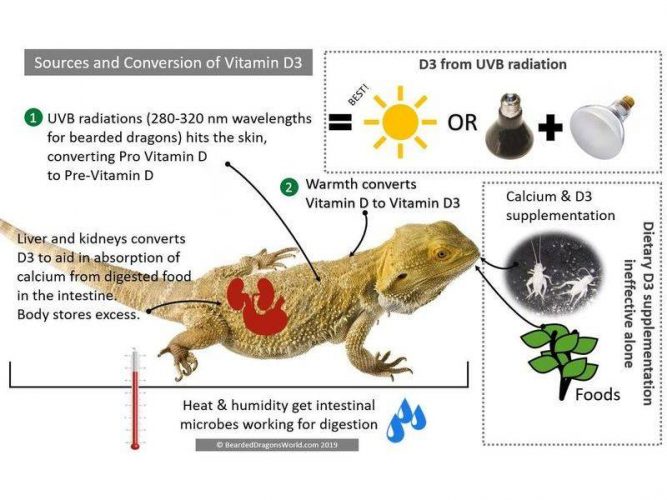
Why Vitamin D3 is a Must for Calcium Absorption
- Vitamin D3’s Role: It’s vital for the metabolism and absorption of calcium and phosphorus in bearded dragons. Without Vitamin D3, the calcium you provide is almost useless.
- Health Benefits: Vitamin D3 supports the immune system, bone development, cardiovascular health, nerve and muscle function, and reproductive health.
- Calcium Deficiencys & Vitamin D3: Calcium deficiency is often accompanied by vitamin D3 deficiency. Vitamin D3 given as a supplement orally is not as effective as it is from giving access to sunlight without any barriers between the UVB and the bearded dragon.
How to Provide Vitamin D3
- Sunlight Exposure: The skin of bearded dragons naturally produces Vitamin D when exposed to UVB rays from sunlight.
- Supplementation: Research on juvenile bearded dragons found that supplementing with vitamin D3 in doses as high as 4 times the average dietary recommendation was ineffective whereas UVB exposure to the skin was significantly beneficial (Oonincx 2010).
- Dietary Sources: Vitamin D3 can also be obtained through diet and supplements. Bearded dragons may be fed calcium with or without vitamin D3. However, where sunlight is provided on a regular basis (i.e. multiple hours per week), oral D3 supplementation should be reduced or not fed at all.
- Storage in the Body: Once absorbed, Vitamin D can be stored in fat tissue, the liver, and kidneys.
Vitamin D3 Key Summary
- Ensure UVB Exposure: UVB lighting or natural sunlight is essential for your bearded dragon to produce Vitamin D3 and absorb calcium effectively.
- Vitamin D3 Supplementation: Vitamin D3 can be ineffective and dangerous if overdosed. Natural sunshine is a safe and effective way of delivering Vitamin D3, alternatively UVB lighting. Overdosing can result in mineralisation of tissues, including the kidneys, which can lead to renal disease.
- Calcium Supplementation: Always provide calcium for bearded dragons.
Why Your Bearded Dragon Needs Enough Calcium
Providing sufficient calcium for bearded dragons is critical to avoid serious health problems.
Causes of Low Calcium in Bearded Dragons
- Not Enough UVB Light: They need UVB light to help their bodies use calcium.
- Not Enough Calcium in Their Diet: It’s important to feed them calcium-rich foods.
- Too Much Vitamin A: It can mess with how vitamin D3 works, which is crucial for calcium use.
- Too Much Phosphorus: A high phosphorus diet or the wrong balance with calcium can lead to problems.
- Too Much Protein: A diet too high in protein can also affect calcium levels.
Signs Your Bearded Dragon Might Not Have Enough Calcium
- Muscle Issues: Like shaking, twitching, or even seizures.
- Weird Movements: They might move strangely or seem off balance.
- Bone Problems: Weak bones, deformities, or even fractures.
- General Weakness: They might seem less active or have trouble moving.
- Digestive Issues: Like constipation or, in severe cases, prolapse.
Special Cases to Watch Out For:
Hypocalcaemia is low levels calcium in the blood. It is mainly due to insufficient calcium especially at times of great need:
- Young Dragons: Hatchling and juvenile bearded dragons grow fast and need plenty of calcium.
- Egg-Laying Females: Extra calcium is required by female bearded dragons to lay healthy eggs.
Calcium for bearded dragons is key to preventing metabolic bone disease, a serious condition similar to osteoporosis in humans. It’s totally preventable with the right care.
A balanced diet and proper UVB lighting are essential for your bearded dragon’s health.
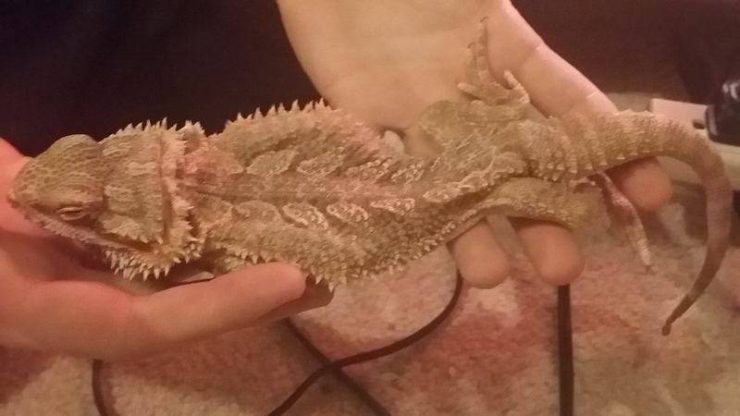
Can you give a Bearded Dragon too much Calcium?
Yes you can give a bearded dragon too much calcium. Overdosing on calcium, particularly when combined with high levels of vitamin D3, can lead to health issues.
- The Right Amount: Calcium is essential for your bearded dragon’s health, but balance is key.
- Vitamin D3 Role: It helps in the absorption of calcium but needs to be in harmony with calcium levels.
What Happens if a Bearded Dragon has too Much Calcium?
Common causes of overdose:
- Excessive Supplements: Both UVB exposure and oral supplements of vitamin D3 need to be regulated.
- Improper Lighting: Artificial UVB lighting must be carefully managed to prevent overexposure.
If a bearded dragon has too much calcium it could result in hypercalceia and interfere with nutrient uptake.
- Hypercalcemia: An excess of calcium in the bloodstream, potentially harmful or even fatal.
- Nutrient Interference: Too much calcium can disrupt the absorption of other vital nutrients.
- Physical Symptoms: Including changes in bone density, muscle issues, and overall discomfort.
| Sign | What It Means |
|---|---|
| Lethargy | Your dragon is less active than usual. |
| Muscle Weakness | Moving seems harder for them. |
| Constipation | Their digestion is off. |
To prevent overdosing a bearded dragon with calcium:
- Monitor Vitamin D3 Levels: Ensure a balanced intake to aid calcium absorption without excess.
- Optimize UVB Lighting: Set up their habitat to mimic natural conditions, providing areas to bask and hide.
- Dietary Management: Adjust how much calcium is provided if other foods include calcium in their ingredients such as commercial foods.
Key Points: Can you give a Bearded Dragon too much Calcium?
- Balance Is Crucial: Too much calcium can be just as problematic as too little.
- Watch for Symptoms: Recognizing signs of overdose can help in taking timely action.
- Environment Matters: A well-set habitat allows your bearded dragon to regulate its own UVB exposure, aiding in calcium absorption.
By being mindful of these guidelines, you can ensure your bearded dragon receives the necessary calcium for optimal health without the risk of overdose.
Why Do We Dust with Calcium When They Don’t Get it in the Wild?
Why do we dust calcium on bearded dragons food? Bearded dragons don’t get calcium dusting in the wild but they are very good at converting UVB radiation (sunlight) into vitamin D3. In the wild, this aids them in being able to use calcium efficiently. In addition, bearded dragons access a wide range of foods in the wild not possible to replicate in captivity.
| Aspect | In the Wild | In Captivity |
|---|---|---|
| UVB Exposure | Direct sunlight converts to D3 | Limited; relies on artificial UVB |
| Natural Diet | Degraded bone, snail shells | Requires supplemented calcium |
| Vitamin D3 Production | High due to ample sunlight | Reduced; needs supplementation |
Natural Sources Calcium for Bearded Dragons in the Wild
A study by Oonincx et al. (2015) analyzed the stomach contents of ten wild Pogona vitticeps, revealing a small amount (2.3%) of indigestible material, including bits of degraded bone. It was suggested that these fragments could contribute to the bearded dragons’ calcium intake in their natural habitat.
Further investigations, such as those noted by Baines (2017), indicate that bearded dragons might also derive calcium from other natural elements like dried bones, snail shells, and possibly even chalky rock dust. These findings shed light on the diverse ways bearded dragons can fulfill their calcium needs in the wild.
Do Bearded Dragons Need Sunlight?
Bearded dragons need some form of UVB and will do best with sunlight. There should be nothing blocking the sun light which includes any glass, plastic or otherwise. Being transparent (such as glass) does not mean it allows UVB rays to pass through it.
Mesh screens reduce the amount of UVB that transmits through it. The tighter the mesh, the less UVB it will allow through. Use aviary wire mesh or similar on outdoor housing. Second is, provide UVB bulbs in your bearded dragons housing.
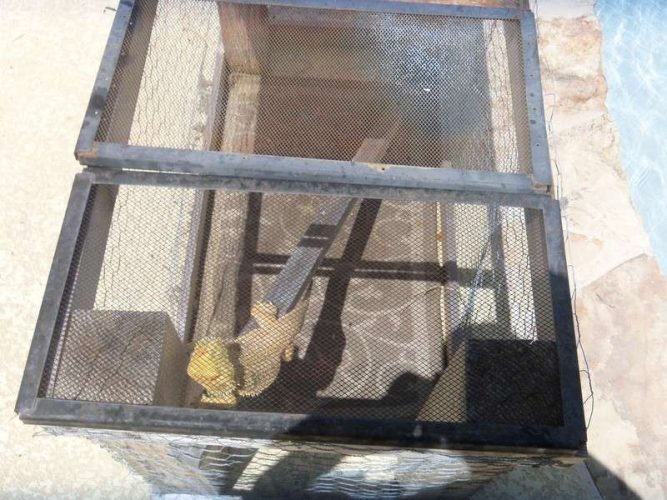
Bearded dragons need full spectrum or high UVB reptile bulbs provided overhead. UVB radiations of only 280-320 nm wavelengths are useful for bearded dragons for vitamin D production in their skin. Lamps below 290 nm are of no use for bearded dragons.
Changing UVB lamps is expected to be between 6 to 12 months. Be diligent in changing out your UVB lamps as per the manufacturer’s instructions. Alternatively, you can buy a UV meter to the UVB output of the lamp. Check your lighting and heating setup against the post on setting up lighting and heating.
Lack of exposure to UVB source can lead to calcium deficiency in bearded dragons. This condition is more pronounced in baby dragons as need more amount of calcium to build their developing and growing skeleton.
Observations show that bearded dragons experience improved appetite, better growth, remain healthier and more active in provision of sunlight and/or UVB generating bulbs or fluorescent type tubes.
Remember, nothing beats natural exposure to sunlight even if only for a few hours a week.
References
- Frances Baines (MRCVS). 2017. Your First Bearded Dragon Care Information.
- Boyer, T. H. B., DVM, DABVP (Reptile and Amphibian. (2021, November 3). Reptile and Amphibian Nutrition. LafeberVet.
- Bruce, H.M.; Parkes, A.S. 1950. Rickets and osteoporosis in Xenopus laevis. Journal of Endocrinology: 64-81.
- Cusack, L., Rivera, S., Lock, B., Benboe, D., Brothers, D., & Divers, S. (2017). Effects of a light-emitting diode on the production of cholecalciferol and associated blood parameters in the bearded dragon (pogona vitticeps). Journal of zoo and wildlife medicine. 48(4), 1120-1126.
- De Vosjoil, P., Sommella, T. M., Mailloux, R., Donoghue, S., & Klingenberg, R. J. (2016). The Bearded Dragon Manual: Expert Advice for Keeping and Caring For a Healthy Bearded Dragon. Lumina Media.
- Diehl, J. J. E., Baines, F. M., Heijboer, A. C., van Leeuwen, J. P., Kik, M., Hendriks, W. H., & Oonincx, D. G. A. B. (2018). A comparison of UV b compact lamps in enabling cutaneous vitamin D synthesis in growing bearded dragons. Journal of animal physiology and animal nutrition, 102(1), 308-316.
- Divers, S. J., & Mader, D. R. (Eds.). (2005). Reptile medicine and surgery. Elsevier Health Sciences.
- Divers, S. J., and Stahl, S. J. (2018) Mader’s Reptile and Amphibian Medicine and Surgery- E-Book. Elsevier Health Sciences.
- Donoghue, S. ARAV (2015) Companion Reptile Care Series. How to Keep Your Iguana Healthy, Happy and Safe! NAVO Revised.
- Girling, S. (2003). Veterinary nursing of exotic pets. Oxford, United Kingdom: Blackwell.
- Klaphake, E. (2010). A fresh look at metabolic bone diseases in reptiles and amphibians. Veterinary Clinics: Exotic Animal Practice. 13(3), 375-392.
- Oonincx, D.G.A.B., Stevens, Y., Borne J.J.G.C. van den., Leeuwen J.P.T.M. van., Hendriks W.H. (2010) Effects of vitamin D3 supplementation and UVb exposure on the growth and plasma concentration of vitamin D3 metabolites in juvenile bearded dragons (Pogona vitticeps). Comparative Biochemistry and Physiology, Part B156: 122–128
- Oonincx, D. G. A. B., Van De Wal, M. D., Bosch, G., Stumpel, J. B. G., Heijboer, A. C., van Leeuwen, J. P. T. M., Hendriks, J. P. & Kik, M. (2013). Blood vitamin D3 metabolite concentrations of adult female bearded dragons (Pogona vitticeps) remain stable after ceasing UVb exposure. Comparative Biochemistry and Physiology Part B: Biochemistry and Molecular Biology, 165(3): 196-200.
- Oonincx, D. G. A. B., Leeuwen, J. P. van., Hendriks, W. H., Poel, A. F. B. van der. (2015) The Diet of Free-Roaming Australian Central Bearded Dragons (Pogona vitticeps). Zoo Biology 34:271-277. Wiley Periodicals Inc.
- Oonincx, D. G. A. B., Stevens, Y., van den Borne, J. J. G. C., van Leeuwen, J. P. T. M., & Hendriks, W. H. (2010). Effects of vitamin D3 supplementation and UVb exposure on the growth and plasma concentration of vitamin D3 metabolites in juvenile bearded dragons (Pogona vitticeps). Comparative Biochemistry and Physiology Part B: Biochemistry and Molecular Biology, 156(2), 122–128.
- Schmidt-Ukaj S., Hochleithner M., Richter B., Hochleithner C., Brandstetter D., Knotek Z. A survey of diseases in captive bearded dragons: a retrospective study of 529 patients. Veterinarni Medicina, 62, 2017 (09): 508–515.
- Stahl, S., and Donoghue, S. Nutrition of Reptiles. In: Hand MS, Thatcher CD, Remillard RL, et al, editors. Small Animal Clinical Nutrition. Topeka (KS): Mark Morris Institute; 2010.
- Thompson, K. S. 2016. Applied Nutritional Studies with Zoological Reptiles. (Doctoral Dissertation) Oklahoma State University
- Watson, M. K., & Mitchell, M. A. (2014). Vitamin D and ultraviolet B radiation considerations for exotic pets. Journal of Exotic Pet Medicine, 23(4), 369-379.
- Yeates, J. (Ed.). (2019). Companion animal care and welfare: The UFAW companion animal handbook. John Wiley & Sons.
